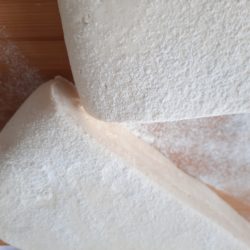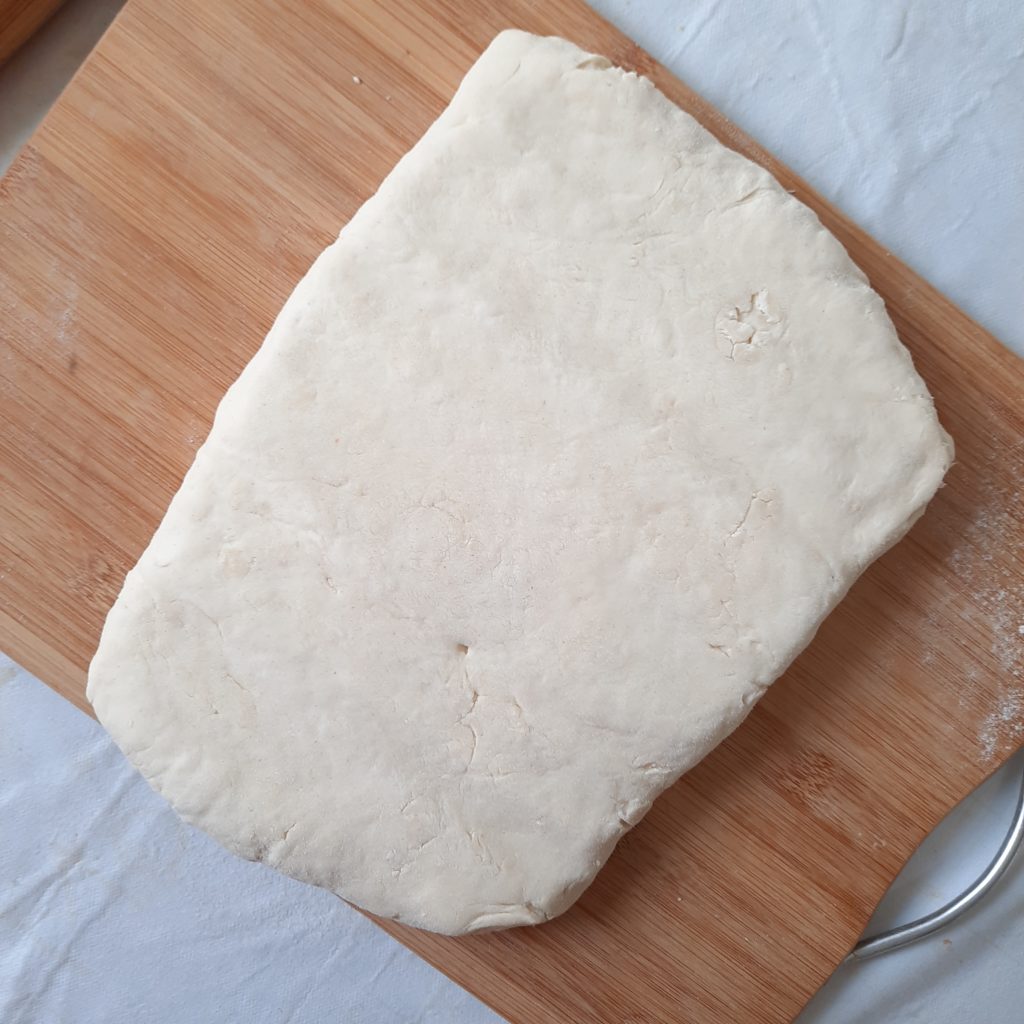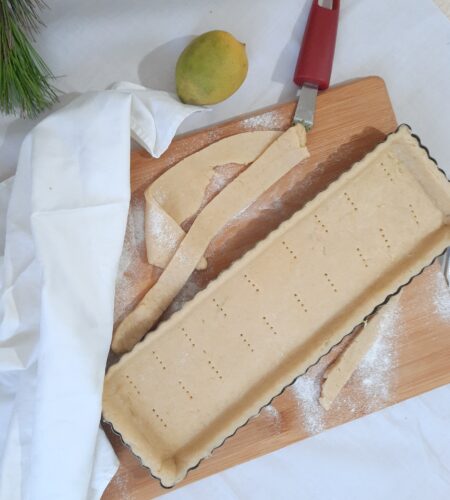Puff pastry a flaky type of pastry that can be used in many different ways. It’s obtained by successively folding layers alternating a basic dough (flour, water and salt) and a fat (oil, margarine or butter). Here’s everything you need to know to make puff pastry from scratch.
Origin and history
the origin of puff pastry dates back to Antiquity and among the Greeks 2000 or 3000 years ago (we don’t know exactly). It was very thin crispy pancakes placed on top of each other and separated by a thin layer of cream.
This puff pastry was discovered by the Romans during their conquests. It was then used in Byzantium which was conquered in 330 AD and renamed Constantinople (present-day Istanbul) and was quickly adopted by the Arabs. And so it was in the 9th century, that it arrived in Spain and in the south-west of France: pastis, croustade, pastilla are its distant descendants.
Two centuries later, the puff pastry took another route, still from the Middle East. The Crusaders introduce it to France while the Turks implant it in Austria, the country they invaded.
The techniques were then transmitted orally for centuries. It was not until 1604 and the publication of the first cookbook, the Kitchen Opening by Lancelot de Casteau, master chef of the princes of Liège, that the first written record was obtained. The puff pastry was obtained by folding a dough roll and no longer by piling up sheets on top of each other and was mentioned for the use of pies. The tempera was made from “the whitest flour you can get”, eggs and a little butter. No quantity was specified. Who had the idea, before, to perform these folds? Nobody knows.
Another mystery exists as to the butter enclosed in the dough. It would be the painter Claude Gellée, known as Le Lorrain (1600 – 1682) who would have invented this process. At 12 years old when he was an apprentice, he wanted to make a special bread for his sick father forced to a special diet based on bread and butter. He put pieces of butter in a ball of bread dough. It was a failure. He started again with a bread dough which he decided to fold over several times on a layer of butter to make it disappear. Once baked, he got a very puffy bread and when he cut it, he discovered leaves inside. Without knowing it, he had invented Dutch puff pastry, now called quick puff pastry (flaky pastry).
The tourage – the name of the folding technique specific to puff pastry – will be better specified and perfected a few years later by M. Feuillet, the pastry chef of the Prince de Condé, in his “Pastry chef royal parisien” published in 1810. Antonin Carême (1784 – 1833) refined the technique of lowering, folding and turning the dough several times. This turning, known as 5 turns, gives 730 dough sheets interspersed with 729 sheets of butter, or 1459 sheets of dough and butter superimposed on each other! The steam in the water contained in the butter then causes the dough to rise when it is cooked while the latter liquefies, preventing the dough leaves from sticking together.
Tips and notes
The preparation of the puff pastry is cariied out down into 3 steps:
- Détrempe: preparation of the Dough.
- Buttering: preparation of the butter.
- Tourage (folding): is the operation of folding the dough and butter 6 times, which can be carried out in single turns (dutch pastry) or in double turns.
Here are some tips to make a successful puff pastry:
- Use a flour rich in gluten and with an elastic-expandable gluten structure.
- No successful puff pastry without real fat. Opt for butter with 80% fat or, if you prefer, special flaky margarine.
- Adding the white vinegar will keep the puff pastry for several days, avoiding the formation of black spots.
- Store your butter in the refrigerator until ready to use. Otherwise, it will spill out of the dough during folding! And if, despite all your precautions, the drama occurs, place the dough in the fridge for 10 minutes.
- The most important thing to keep in mind when making these kinds of pastries is to keep them nice and cold at all times. Since a puff pastry is made up of superimposed layers of butter and flour. If you work in an overheated room, the layers of butter melt. The result, a dough that rises less well.
- Never form a ball of your dough but always respect the folding process.
- Respect the rest times is necessary for the dough. If it does not have enough time to cool, it will be too soft and impossible to work. So, do not shorten the rest time of the dough: 30-60 minutes for the dough, same thing after the first folding. And once the folding is complete, wrap it with cling film before storing it again for 30 minutes in the fridge.
- The number of turns may seem a detail but it is not one! I advise you to make 6. You will get a nice feuilletage.
- The puff pastry can be kept for up to four days in the fridge before use. It can also be frozen. It will keep for several weeks in the freezer, tightly wrapped.
Uses
The puff pastry is very versatile and can be used in so many ways, both sweet and savory: desserts, pies, cakes (mille-feuilles, jalousies, turnovers, Jesuits …), savory tarts, pizza, …

Puff pastry
Ingredients
- 650 g bread flour (higher protein flour)
- 500 g butter (at 16°C-60.8°F)
- 300-325 ml water
- 10 g salt
- 1 tsp white vinegar
Instructions
Preparing the dough
- In a bowl, add the flour and the salt, then gradually pour the cold water and vinegar over the flour. You must obtain a homogeneous and fairly hard dough.
- Shape it into a square a centimeter thick. Wrap it in cling film and let it sit for 30-60 minutes in the refrigerator.
Preparing the butter
- Spread the butter with a little flour between 2 sheets of parchment paper to form a square one centimeter thick.
Tourage
- Place the butter in the center of the dough. Wrap the butter by folding the corners of the dough.
- After having completely covered the butter, level the surface to make it homogeneous. Continue until it is 8-9 mm (0.3 in) thick.
- Fold the dough in 3 (in a wallet) one end over a third of the length and the other end to cover everything. Turn the dough a quarter of a turn to the right.
- Repeat the operation: Press the top and bottom of the dough so that the layers of leaves do not shift. Spread again on a thickness of 8 to 9mm (0.3 in). Fold in three again and wrap the dough in cling film. Let it sit in the fridge for 30 min.
- After this rest, give it 2 simple turns again, turning it a quarter of a turn every time. Leave to rest for another 30 minutes in the refrigerator covered with cling film.
- Turn the dough again a quarter of a turn and give it two simple turns.






























Sources: 1. https://www.academiedugout.fr/articles/la-pate-feuilletee-craquante-depuis-3000-ans_3241 2. https://www.boulangerienet.fr/bn/bnweb/dt/feuilletage.php






[…] can use a shortcrust pastry, a puff pastry or a shortbrad pastry but the authentic recipe is made with a shortcrust […]
[…] Puff pastry; […]